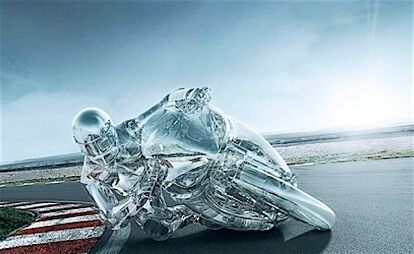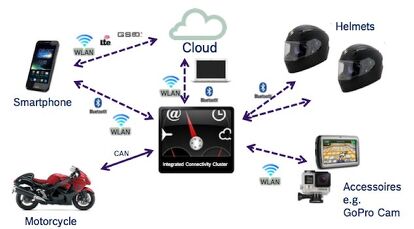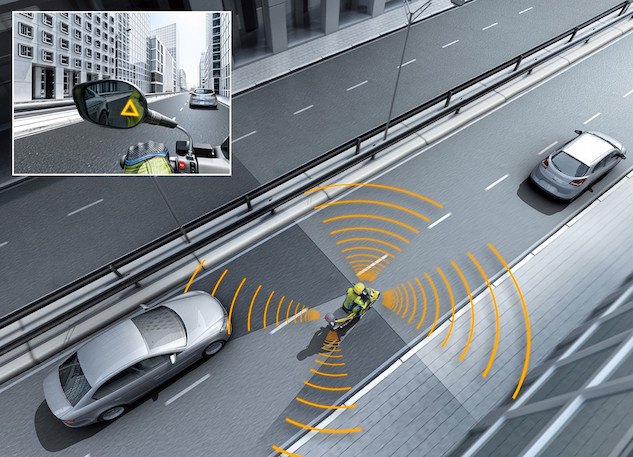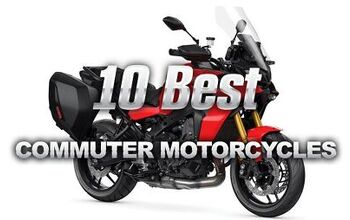Technological Strategies To Motorcycle Safety
Bosch brings Motorcycle Stability Control now, Vehicle-to-Vehicle communication soon
It’s nearly impossible to purchase a new motorcycle that doesn’t include some form of pre-installed electronic rider aid. From cornering ABS to switchable ride modes, on-the-fly adjustable traction control to hill-hold start, the variety of rider aids made available in just the last few years is mind blowing.
Behind much of this electronic rider aid development is Bosch – the privately held German company with motorcycle ABS research dating back to 1984. More recently, Bosch has been one of the leading purveyors of traction-control systems on motorcycles from several manufacturers.
Bosch’s latest advancement is its integrated Motorcycle Stability Control system seen on flagship models such as KTM’s Super Adventure and Super Duke GT. The all-in-one system combines lean-angle dependent brake control with electronically linked brakes to provide optimum stopping performance in any scenario. The system also incorporates lean-angle-dependent traction control that includes algorithms for mitigating front- and rear-wheel lift.
In addition to its Motorcycle Stability Control system, Bosch is busy developing small, lightweight, and affordable ABS units for motorcycle manufacturers in emerging markets, as well as looking to the future of the worldwide motorcycle safety industry by developing technologies that will further connect riders with cloud-based motorcycling. Bosch is so serious about its motorcycle future it introduced a Two-Wheeler and Powersports division of the company last year, and positioned the headquarters in Yokohama, Japan.
We recently spent some time with leading figures from Bosch’s Two-Wheeler and Powersports division at the International Driver & Rider Training Symposium. From them, we learned how extensive the German company’s roots are in motorcycling, and peered into the future of electronic motorcycle safety.
Side View Assist
Already available from Bosch on BMW’s C650GT scooter is Side View Assist technology for monitoring blind spots on motorcycles. The system uses four ultrasonic sensors to monitor the surrounding area up to 16 feet away, at speeds between 15 to 50 mph. While the rear sensors monitor areas behind the scooter, the two front sensors provide a plausibility check. If the front sensors detect an object before the rear sensors (such as an oncoming vehicle or parking car), the control unit determines there is no threat and does not issue a warning. When a vehicle is in the rider’s blind spot, the technology emits a visual warning via a signal close to the appropriate rearview mirror.
It’s interesting to note that while Bosch supplies the Side View Assist technology, how the rider is notified is determined by the OEM. For example, BMW chose to notify C650GT riders of possible unseen vehicles via a blinking warning signal at the base of the mirror. “OEMs have the freedom to choose how a Bosch technology is implemented on individual vehicles,” says Bosch Two-Wheeler & Powersports Manager, Winson Wang. “The location of the notification as well as the type of notification – such as whether it’s haptic or sound – is optional, and once determined Bosch adapts the technology accordingly.” This variability applies to other Bosch technologies as well as Side View Assist.
Integrated Connectivity Cluster
Like Bosch’s Motorcycle Stability Control, the Integrated Connectivity Cluster utilizes Bosch’s Connectivity Control Unit (CCU) to integrate a system connecting you to your motorcycle and your motorcycle to all things internet. Working in conjunction with Bosch’s communication center in Fort Lauderdale (opened in 2014) the CCU will be able to provide the following services.
- Emergency Call
If the motorcycle is involved in a crash and the rider is incapacitated, the CCU automatically sends a message containing geographical coordinates and rider information to a call center. An operator at the call center then notifies emergency services. Beginning in April, 2018 all EU passenger cars and trucks are mandated to have this technology. BMW recently announced the addition of this technology to its European motorcycle models beginning next year. According to a pan-European eCall trial conducted in 2011, the study found emergency services were able to arrive at accident scenes 40-50% faster when responding to vehicle-integrated call systems. - Breakdown Call
Similar to the Emergency Call, a rider initiates a Breakdown Call by depressing the bCall button which triggers the CCU to contact a call center. The call center then contacts a local dealership, garage or towing service and provides available information. - Information Call
A rider places an Information Call to the call center where an agent books the requested service, such as locating the nearest hotel, making a reservation, and providing the rider with GPS directions. - Stolen Vehicle Tracking
If you’re away from your bike and it gets stolen, the CCU transmits a signal to an app on your smartphone or to the call center. Once confirmed the bike is stolen, the call center can help law enforcement find the motorcycle by providing its current position. - Telemetric Recording
When signaled the CCU instructs the telemetric recorder to begin collecting data (speed, lean angle, acceleration, brake pressure, etc.) and sending that data to a cloud service where it can be downloaded and analyzed later. BMW introduced similar technology a couple years ago with its HP Data Logger, as did Yamaha when it launched the new R1 last year.
Bosch introduced similar eCall technology at this year’s Consumer Electronics Show in the form of an adaptor that connects to a car’s cigarette lighter socket, which also utilizes Bosch’s Florida-based communication center. When CCU technology is introduced to US motorcyclists “Bosch will be leveraging the existing call center to take advantage of its services,” says Wang.
The CCU also provides riders with useful information on issues such as potential road hazards, traffic congestion, changing weather conditions, etc.
Vehicle-to-Vehicle Communication
I wrote about Vehicle-to-Vehicle (V2V) communication during Motorcycle Safety Month (May) two years ago ( The Future Of Motorcycle Safety Awareness Month). For motorcyclists, the technology can’t arrive soon enough. According to Bosch, “The rate of motorcycle fatalities have not declined in proportion to the overall decline in all highway fatalities.” The National Highway Traffic Safety Administration (NHTSA) confirms Bosch’s statement with these figures: 1) Motorcycles comprise only 2% of registered vehicles, but account for 5% of annual traffic fatalities. 2) The fatality rate per miles traveled for motorcyclists is 16 times that of car occupants.
As Bosch develops V2V communication and helps integrate the technology into our mobile society, these tragically embarrassing NHTSA stats should tumble. If a motorcycle can, via V2V, communicate with an approaching vehicle and ensure it doesn’t turn left until the motorcycle has passed, that’ll eliminate a huge cause of motorcycle accidents.
“The exchange of data through vehicle-to-vehicle communication technology generates an awareness of the motorcycle that ensures drivers of other vehicles know of the motorcycle’s presence without actually even seeing it directly,” Bosch explains in a press release. “In addition to the enhancement of road safety, the interconnection of cars, motorcycles, trucks, and buses will generally help to prevent traffic congestion and jams, sparing both the environment and drivers’ nerves.”
The Bosch Integrated Connectivity Cluster also interfaces with Bluetooth devices such as smartphones and helmet communicators, as well as WLAN devices such as cameras and GPS devices. Bosch is not intending to develop a smart helmet but does envision Bosch technology getting into those helmets.
BMW Introduces HUD Helmet Concept
According to Bosch’s Tony Szczotka, many of the technologies presented here are already available or will be soon. Exactly where Bosch focuses its efforts depends on consumer trends as well as the legislative environment. The end goal for Bosch “is to use the technology to improve safety and help reduce motorcycle fatalities,” says Szczotka.
Fans and haters of modern motorcycle electronic rider aids have Bosch to either thank or despise. Haters, though, best get on board with the technological tidal wave, because the rider-aid box is open and there’s no shutting it now. And why would we?
Anti-lock brakes – once a ponderous, questionably beneficial appendage mounted to flagship BMWs – has been transformed into smart systems that often can be adjusted depending on rider preferences and environments, and faster processors mean unwanted early intervention is largely a thing of the past. Bosch’s latest ABS foray is to develop affordable, lightweight ABS devices that can be fitted to price-conscience motorcycles, especially for Asia and ASEAN markets.
The trend toward smaller, lighter, better performing, more intuitive rider aids is going to continue, which will benefit the safety of all motorcyclists. And Bosch’s new Two-Wheeler & Powersports division will surely be leading the way.
A former Motorcycle.com staffer who has gone on to greener pastures, Tom Roderick still can't get the motorcycle bug out of his system. And honestly, we still miss having him around. Tom is now a regular freelance writer and tester for Motorcycle.com when his schedule allows, and his experience, riding ability, writing talent, and quick wit are still a joy to have – even if we don't get to experience it as much as we used to.
More by Tom Roderick



































Comments
Join the conversation
That company must be a monster.When will we break free of the ever increasing shackles of modern technology?Will the bike/car not run if it isn't connected to the web soon?Agree with John B on this one.
If ever you were at a sailboat's helm beating windward and in the pocket, you have felt the wind, the sails, your body, the keel, and the water in perfect unity; and, you understand technological advancement leaves in its wake some phenomenal experiences.